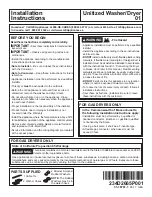
Before Operating Your Dryer
Read your dryer Owner’s Guide.
It has important safety and
warranty information. It also has many suggestions for best drying
results.
To reduce the risk of fire, electric shock or injury
to persons, read the IMPORTANT SAFETY INSTRUCTIONS in
your dryer Owner’s Guide before operating this appliance.
Operating Steps
Read “Drying Procedures” in your Owner’s Guide. It explains
these operating steps in detail.
1. Prepare items for drying.
2. Check that lint screen is clean and in place.
3. Load the dryer. If desired, add a dryer fabric softener sheet.
Close the door.
4. Select the cycle and drying temperature for each load. To
change the temperature, turn the TEMP knob to the desired
temperature.
5. A suitable dryness level and options will automatically be
displayed for each cycle. To change the dryness level, press
DRYNESS until the desired selection is made. To select an
option, press OPTIONS until the indicator for a desired option
flashes and press Select. Follow the same steps to delete
an option. If a dryness level or option is not available for a
cycle, it will not light.
6. The changes you make will be remembered the next time
that cycle is selected. See the “Dryer Settings Chart” for
more details.
7. Press START to begin cycle.
•
To pause the cycle or change settings, press Pause/
Cancel once.To resume the cycle, press START again.
•
To stop or change the cycle, press Pause/Cancel twice.
8. A signal will sound at the end of the cycle and periodically
during Press Saver when the Cycle Signal option is selected.
When the cycle ends, remove items immediately and hang or
fold.
9. Clean the lint screen after every load.
Cycle Selection
For best results, follow the fabric care label instructions on items
to be dried.
Auto Dry
Auto Dry cycles take the guesswork out of drying time. The load
will automatically be dried at the selected temperature to the
desired dryness level. The dryer senses the moisture level of the
load as it tumbles through heated air. Auto Dry cycles save time
and energy and protect fabrics.
PN 137102200 (0806)
DRYER OPERATING INSTRUCTIONS
When the load has reached the selected dryness level, it will
continue to tumble, unheated, during a Cool Down period. This
helps reduce wrinkling and makes items easier to handle during
unloading.
Drying time varies depending on size and dampness of load,
weight and fabric type. Room temperature and humidity, type of
installation and electrical voltage or gas pressure can also affect
drying time.
Towels
Select this Auto Dry cycle for towel loads.
Normal
Select this Auto Dry cycle for cotton items.
Perm Press
Select this Auto Dry cycle to dry cottons and blends with a no-
iron finish.
Delicate
Select this Auto Dry cycle for knits and delicate items.
Quick
Select this cycle to quickly dry a small load made up of just a
few items. It provides approximately 20 minutes of tumbling fol-
lowed by a 10-minute cool down period.
Touch Up
Select Touch Up to help remove wrinkles from clean and dry
items that were not taken from the dryer at the end of the cycle,
have been stored in crowded closets or drawers, or unpacked
from luggage following a trip. It provides approximately 10 minutes
of tumbling followed by a 5-minute cool down
period.
Timed Dry
To manually select the drying time for any load, turn the knob to
a numbered setting. Drying times from 15 to 90 minutes are
available in 15-minute increments. You will not be able to select
a cycle or dryness level. Timed Dry is recommended when us-
ing the No Heat option.
Note:
To change cycles, press Pause/Cancel twice.
Temperature Selection
For best results, follow the fabric care label
instructions on items to be dried.
High
is recommended for sturdy fabrics.
Medium
is recommended for wrinkle free, permanent press and
lightweight fabrics.
Low
is recommended for delicate fabrics.
No Heat
should only be used with a Timed Dry setting to dry
items containing feathers, down, foam rubber, plastics or rub-
ber-like materials; to freshen clothing, pillows or blankets; or to
dust draperies.


























